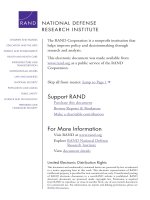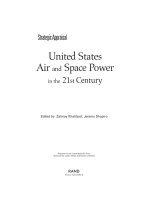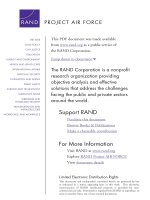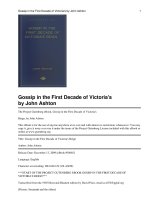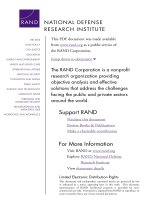Air Power in the New Counterinsurgency Era - The Strategic Importance of USAF Advisory and Assistance Missions ppt
Bạn đang xem bản rút gọn của tài liệu. Xem và tải ngay bản đầy đủ của tài liệu tại đây (1.03 MB, 206 trang )
This document and trademark(s) contained herein are protected by law
as indicated in a notice appearing later in this work. This electronic
representation of RAND intellectual property is provided for non-
commercial use only. Permission is required from RAND to reproduce, or
reuse in another form, any of our research documents.
Limited Electronic Distribution Rights
Visit RAND at www.rand.org
Explore RAND Project AIR FORCE
View document details
For More Information
This PDF document was made available
from www.rand.org as a public service of
the RAND Corporation.
6
Jump down to document
THE ARTS
CHILD POLICY
CIVIL JUSTICE
EDUCATION
ENERGY AND ENVIRONMENT
HEALTH AND HEALTH CARE
INTERNATIONAL AFFAIRS
NATIONAL SECURITY
POPULATION AND AGING
PUBLIC SAFETY
SCIENCE AND TECHNOLOGY
SUBSTANCE ABUSE
TERRORISM AND
HOMELAND SECURITY
TRANSPORTATION AND
INFRASTRUCTURE
WORKFORCE AND WORKPLACE
The RAND Corporation is a nonprofit
research organization providing
objective analysis and effective
solutions that address the challenges
facing the public and private sectors
around the world.
Purchase this document
Browse Books & Publications
Make a charitable contribution
Support RAND
This product is part of the RAND Corporation monograph series.
RAND monographs present major research findings that address the
challenges facing the public and private sectors. All RAND mono-
graphs undergo rigorous peer review to ensure high standards for
research quality and objectivity.
Alan J. Vick, Adam Grissom, William Rosenau, Beth Grill,
Karl P. Mueller
Prepared for the United States Air Force
Approved for public release; distribution unlimited
PROJECT AIR FORCE
Air Power in the New
Counterinsurgency Era
The Strategic Importance of USAF
Advisory and Assistance Missions
The RAND Corporation is a nonprofit research organization providing
objective analysis and effective solutions that address the challenges
facing the public and private sectors around the world. RAND’s
publications do not necessarily reflect the opinions of its research clients
and sponsors.
R
®
is a registered trademark.
© Copyright 2006 RAND Corporation
All rights reserved. No part of this book may be reproduced in any
form by any electronic or mechanical means (including photocopying,
recording, or information storage and retrieval) without permission in
writing from RAND.
Published 2006 by the RAND Corporation
1776 Main Street, P.O. Box 2138, Santa Monica, CA 90407-2138
1200 South Hayes Street, Arlington, VA 22202-5050
4570 Fifth Avenue, Suite 600, Pittsburgh, PA 15213
RAND URL: />To order RAND documents or to obtain additional information, contact
Distribution Services: Telephone: (310) 451-7002;
Fax: (310) 451-6915; Email:
Cover image of CT team: Combat Aviation Advisors from the 6th SOS and regular
army soldiers from Chad in front of a Chad Air Force C-130.
The research described in this report was sponsored by the United States
Air Force under Contract F49642-01-C-0003. Further information may
be obtained from the Strategic Planning Division, Directorate of Plans,
Hq USAF.
Library of Congress Cataloging-in-Publication Data
Air power in the new counterinsurgency era : the strategic importance of USAF
advisory and assistance missions / Alan J. Vick [et al.].
p. cm.
“MG-509.”
Includes bibliographical references.
ISBN-13: 978-0-8330-3963-7 (pbk. : alk. paper)
1. Counterinsurgency—United States. 2. Air power—United States. 3. United
States. Air Force. 4. Military assistance, American 5. Military missions. 6. World
politics—21st century. I. Vick, Alan.
U241.A57 2006
358.4'1425—dc22
2006019803
iii
Preface
With insurgency growing in importance as a national security prob-
lem, it is receiving new interest across the services, in the Department
of Defense (DoD), and elsewhere in the U.S. government. Although
ongoing operations in Afghanistan and Iraq give particular immediacy
to the problem, the challenge of insurgency extends well beyond these
specific conflicts. It is important, therefore, that the U.S. Air Force
(USAF) consider how to meet the growing demand for air power in
joint, combined, and interagency counterinsurgency operations and
that other services’ and DoD-wide reassessments of the subject take the
potential roles of air power in counterinsurgency fully into account.
In particular, airmen should take the lead in exploring how air power
might work in combination with other military and civil instruments
to help avert the development of an insurgency or perhaps to check a
growing insurgency long enough to allow political and social initiatives
(the heart of any successful counterinsurgency strategy) to take hold.
To address these and related policy challenges, RAND Project
AIR FORCE conducted a fiscal year 2005 study entitled “e USAF’s
Role in Countering Insurgencies.” is study addressed four major
policy questions: (1) What threat do modern insurgencies pose to U.S.
interests? (2) What strategy should the United States pursue to counter
insurgent threats? (3) What role does military power play in defeat-
ing insurgencies? (4) What steps should USAF take to most effectively
contribute to counterinsurgency? is work builds on more than 40
iv Air Power in the New Counterinsurgency Era
years of RAND Corporation work on insurgency, peace operations,
and other types of lesser conflicts.
1
is monograph has several purposes and audiences. First, it seeks
to be a short primer on the problem of insurgency, counterinsurgency
principles, and the role of air power in countering insurgencies. It is
hoped that it will be a valuable introduction for airmen new to the
topic. Second, it is hoped that the analysis on the potential demand
for advisory assistance, as well as the data collection and analysis of
recent 6th Special Operations Squadron (6 SOS) missions, will offer
new insights to counterinsurgency practitioners in USAF. Finally, the
monograph seeks to offer senior USAF leaders a way ahead to develop
increased capability in this area without sacrificing the Air Force’s edge
in major combat operations.
e research reported here was sponsored by the Director of Oper-
ational Planning, Headquarters U.S. Air Force, and conducted within
the Strategy and Doctrine Program of RAND Project AIR FORCE.
RAND Project AIR FORCE
RAND Project AIR FORCE (PAF), a division of the RAND Corpo-
ration, is the U.S. Air Force’s federally funded research and develop-
ment center for studies and analyses. PAF provides the Air Force with
independent analyses of policy alternatives affecting the development,
employment, combat readiness, and support of current and future aero-
space forces. Research is conducted in four programs: Aerospace Force
1
Between 1958 and 2005, RAND published over 50 reports with counterinsurgency in the
title. In the same period, the abstracts for over 200 RAND reports included the term. For
an overview of RAND work on this topic, see Austin Long, On “Other War”: Lessons from
Five Decades of RAND Counterinsurgency Research, Santa Monica, Calif.: RAND Corpora-
tion, MG-482-OSD, 2006. One of the earlier RAND works on counterinsurgency reports
the results of a 1962 symposium at which scholars, planners, and practitioners came together
to discuss the state of the art. See Stephen T. Hosmer and S. O. Crane, Counterinsurgency: A
Symposium, April 16–20, 1962, Santa Monica, Calif.: RAND Corporation, R-412-ARPA,
1962. For a more recent work, see Bruce Hoffman, Insurgency and Counterinsurgency in Iraq,
Santa Monica, Calif.: RAND Corporation, OP-127-IPC/CMEPP, 2004a.
Preface v
Development; Manpower, Personnel, and Training; Resource Manage-
ment; and Strategy and Doctrine.
Additional information about PAF is available on our Web site at
/>
Contents
vii
Preface iii
Figures
xi
Tables
xiii
Summary
xv
Acknowledgments
xix
Abbreviations
xxiii
CHAPTER ONE
Introduction 1
Background
1
e Dilemma of Intervention
4
Purpose and Organization of is Monograph
6
CHAPTER TWO
e Evolving Insurgency Challenge 7
Introduction
7
Defining Insurgency
8
Categorizing Insurgencies
12
Sources of Insurgency
16
Insurgency and U.S. Security
20
Conclusion
25
viii Air Power in the New Counterinsurgency Era
CHAPTER THREE
e Challenge of Counterinsurgency:
Lessons from the Cold War and After
27
Introduction
27
Four Principles
32
1. Understand the Adversary
32
2. Build State Capacity and Presence
37
3. Control the Population
41
4. Keep the Use of Force to a Minimum
45
Conclusion
50
CHAPTER FOUR
Grand Strategy and Counterinsurgency 53
Introduction
53
Assessing Insurgent reats to U.S. National Security
54
When Do Insurgencies reaten U.S. Security Interests?
54
e Importance of Insurgency and Counterinsurgency in Future
U.S. Grand Strategy
57
Grand Strategies for Small Wars
59
Differences Between Counterinsurgency and Conventional
Military Requirements
59
Differences Between Counterinsurgency and Conventional
Military Strategy
62
Coercion in Counterinsurgency
64
Options for Counterinsurgency Intervention
69
e Diversity of Counterinsurgency
69
Ideal Types: Precautionary and Remedial Counterinsurgency
70
Advantages and Limitations of Precautionary Counterinsurgency
72
Investing in Counterinsurgency Capabilities
74
Optimizing Military Capabilities for Counterinsurgency
74
When, How, and Where Will the United States Intervene?
76
e Roles of Allies in Counterinsurgency
77
Contents ix
CHAPTER FIVE
A New Framework for Understanding and Responding to
Insurgencies
81
e Application of Military Power to Counterinsurgency
81
Security Cooperation and Foreign Internal Defense
93
Some Caveats on Early Intervention
100
e Power and Limitations of Military Assistance: e El Salvador
Experience
101
El Salvador: Lessons for Future Counterinsurgency Operations
107
CHAPTER SIX
e USAF Role in Countering Insurgencies 109
e Role of Air Power in Counterinsurgency Operations
109
How Should We ink About the Role of Air Power in
Counterinsurgency?
112
Limiting Adversary Conventional Options
113
Balancing Insurgent Advantages
113
Gaining the Initiative
114
Current USAF Operational Aviation Advising Activities
115
6 SOS History
115
Mission
117
Typical Engagements
118
Squadron Organization
119
Manning and Training
120
Trends in Operational Aviation Activity Since 9/11
121
Estimating Demand for Operational Aviation Advising
126
Estimating the Personnel Required for Aviation Advising
Missions
130
Applying the Metric: Manpower Requirements for an Illustrative
Precautionary Strategy
131
Expanding and Deepening USAF Capabilities to Counter
Insurgencies
132
Make Counterinsurgency an Institutional Priority
133
Create Organizations and Processes to Oversee USAF
Counterinsurgency Efforts
133
x Air Power in the New Counterinsurgency Era
Develop and Nurture Counterinsurgency Expertise roughout
USAF
135
Create a Wing-Level Organization for Aviation Advising
136
Enhance USAF Combat Capabilities for Counterinsurgency
146
CHAPTER SEVEN
Conclusions 149
Final oughts
150
APPENDIXES
A. States Afflicted by Insurgency 153
B. Estimating Manpower Requirements for Advisory Assistance
155
Bibliography
159
Figures
xi
5.1. Intervention Options Against a Growing Insurgency 83
5.2. Examples of Counterinsurgency Intervention Strategies
88
6.1. Changes in Number and Length of Missions and
Number of Personnel, 1996–2004
124
6.2. 6 SOS Number of Person Days Deployed per Year
125
Tables
xiii
2.1. Key Differences Between Terrorists and Insurgents 11
6.1. Locations of 6 SOS Missions, 1996–2000
122
6.2. Locations of 6 SOS Missions, 2001–2004
122
6.3. Manpower Required to Meet Various Mission-Day
Goals
132
xv
Summary
Often treated by Americans as an exceptional form of warfare, insur-
gency is anything but. Spanning the globe, centuries, and societies,
insurgency is quite common. e United States itself was founded
by insurgents—British colonists who rebelled against the abuses and
neglect of British rule. At the end of the 19th century, the United
States fought Filipino insurgents in its newly won territory. During
the 20th century, U.S. forces fought insurgents in Nicaragua; Haiti;
the Dominican Republic; the Philippines (again); Vietnam; and most
recently, Afghanistan and Iraq. It has provided support to counterin-
surgent forces in many more locations and support to insurgents in a
few (most notably Nicaragua and Afghanistan).
is monograph seeks to help USAF prepare for future insur-
gency challenges by describing current trends, presenting an overview
of key counterinsurgency principles, exploring counterinsurgency
grand strategy options for the United States, proposing a new pre-
cautionary approach to counterinsurgency, and assessing current and
potential USAF contributions.
Key Findings
e primary insurgent threat to the United States today stems
from regional rebels and global terrorists who share a common
ideology.
1
ese ties allow global terrorists to use a local insur-
1
roughout this report we use insurgent and rebel interchangeably.
•
xvi Air Power in the New Counterinsurgency Era
gency as a training ground, to provide sanctuary, and to motivate
a global audience (pp. 3–4).
Today the only terrorist group with both the capability and desire
to conduct attacks against U.S. interests at home and abroad is al
Qaeda (pp. 24, 55).
e U.S. counterinsurgency priority, therefore, should be the
insurgencies motivated by radical Islam and global jihad. ese
are the ones most likely to find common cause with al Qaeda
(p. 58).
Previous experience with insurgencies has demonstrated that
insurgencies are rarely defeated by outside powers. Rather, the
best role for outsiders is an indirect one: training, advising, and
equipping the local nation, which must win the war politically
and militarily (pp. 4–5).
A precautionary strategy that seeks to defeat the insurgency in its
early stages is the most cost-effective approach, potentially avoid-
ing huge costs in lives and dollars (pp. 82–93).
Because insurgencies are fundamentally driven by social, politi-
cal, and economic issues, nonmilitary aid will often be most
important, especially in the early phases of a rebellion. Support to
the host nation’s police, security, and intelligence organizations is
especially critical and should precede or occur in parallel with mil-
itary assistance. When they are necessary, military actions must
be carefully designed to support the overall political strategy. In
past insurgencies, ill-considered actions by the government’s mili-
tary and security forces often increased insurgent determination
and popular support for the rebels. e United States and leaders
of partner nations must take care lest the military dynamic over-
take the political (pp. 37–41, 45–47).
Because air power has much to contribute to counterinsurgencies
around the globe, advising, training, and equipping partner air
forces will be a key component of U.S. counterinsurgency efforts
(pp. 109–114).
USAF needs a full-spectrum counterinsurgency capability.
Although training, advising, and equipping efforts will be USAF’s
most common role in counterinsurgency, some situations may
•
•
•
•
•
•
•
Summary xvii
require U.S. combat air power to team with indigenous or coali-
tion ground forces or to participate in joint and interagency U.S.
counterinsurgency operations (pp. 146–147).
Recommendations for USAF
USAF possesses a broad range of capabilities, in both its special and
general-purpose forces, that can make significant contributions to
fighting insurgents. Bringing these capabilities to bear on the counter-
insurgency problem will require that counterinsurgency be treated as
a problem as important as conventional warfighting, even though the
manpower, dollars, and force structure devoted to it will likely never
need to be as large as those devoted to major combat operations. To
enhance its contribution to counterinsurgency, USAF should take the
following steps:
Make counterinsurgency an institutional priority. Without
clear signals from senior USAF leaders, the institutional USAF
will continue to treat counterinsurgency either as something that
only the Air Force Special Operations Command (AFSOC) does
or as a lesser included case that requires no special preparation.
Major speeches, vision statements, personnel policy changes,
and new programs will be necessary to overcome this perception
(p. 133).
Create organizations and processes to oversee USAF counter-
insurgency efforts. e USAF will need new organizations to
develop and oversee counterinsurgency policy and concepts, to
integrate efforts across the USAF, to coordinate with DoD and
other agencies, and to execute counterinsurgency advisory and
assistance missions (pp. 133, 135).
Develop and nurture counterinsurgency expertise through-
out USAF. Counterinsurgency expertise does exist in USAF, but,
outside of AFSOC, it is scattered and limited. Substantial coun-
terinsurgency education should be a mandatory part of the cur-
•
•
•
xviii Air Power in the New Counterinsurgency Era
riculum in the Air Force Reserve Officer Training Corps, at the
Air Force Academy, and in all phases of Air Force Professional
Military Education from Squadron Officer School to the Air War
College. Opportunities for more in-depth training and education
will need to be developed, as will appropriate career paths for
counterinsurgency specialists (pp. 135–136).
Create a wing-level organization for aviation advising. is
is likely the single most important initiative USAF can take to
enhance its own counterinsurgency capabilities. By creating
a wing-level organization, USAF will be able to grow its advi-
sory capacity to meet the demand; expand aviation assistance to
include institutional and higher-level advising; develop new coun-
terinsurgency concepts and technologies for partner air forces;
supervise an embedded advisor program; and offer sufficiently
diverse opportunities to attract and retain the very best officers,
noncommissioned officers, and civilian personnel (pp. 136–143).
Enhance USAF combat capabilities for counterinsurgency.
Although only as a last resort, USAF does need the ability to
conduct air operations in support of partner-nation forces and/or
U.S. joint forces fighting insurgencies. USAF already has con-
siderable relevant capabilities, and its modernization programs
will enhance them further. Beyond that, specific technologies
(e.g., foliage-penetrating sensors) and, most important, a deeper
understanding of the insurgent phenomenon will increase the
effectiveness of air power in future counterinsurgency operations
(pp. 146–147).
•
•
xix
Acknowledgments
Maj Gen Roy M. Worden, Director for Operational Plans and Joint
Matters, Headquarters, USAF, was the study sponsor. We greatly appre-
ciate General Worden’s enthusiastic support, his assistance in thinking
through the implications of a precautionary strategy, and his efforts to
ensure that the study recommendations reach key decisionmakers.
Lt Col omas McCarthy, HQ USAF/XOXS, was the study
action officer. We benefited enormously from his expert insights and
recommendations, as well as his careful attention to more-mundane
administrative matters.
We thank Andrew Hoehn, Director of PAF’s Strategy and Doc-
trine Program, for arranging two meetings with senior military lead-
ers who are intensively involved in military assistance activities in
key regions. Gen Charles Wald, USAF, Deputy Commander Euro-
pean Command, and Lt Gen Wallace Gregson, USMC, Commander
Marine Forces Pacific, took time out of their busy schedules to discuss
the challenges of foreign internal defense in their respective theaters.
We thank Lt Gen Jeffrey Kohler, Director, Defense Security
Cooperation Agency; Lt Gen Michael Wooley, Commander, AFSOC;
and Maj Gen John Folkerts, Vice Commander, AFSOC, for their help-
ful comments on the project briefing.
e study team received exceptional support and assistance from
the leadership and personnel of the 6th Special Operations Squad-
ron (6 SOS), Hurlburt Field, Florida. We thank Jerome Klingaman,
Director of Strategy and Plans, 6 SOS, for his encouragement, gracious
hospitality, and generosity in sharing insights he gained as a combat
aviation advisor over the last four decades. We also thank Lt Col Juan
xx Air Power in the New Counterinsurgency Era
Alvarez, Commander, 6 SOS, for supporting our multiple visits and
for his helpful comments on our briefing. SMSgt Hale Laughlin also
shared his expertise and insights with us on multiple visits. Diane Beck,
Program Analysis and Documentation, provided essential help gaining
access to 6 SOS after-action reports and other documents.
AFSOC hosted multiple visits by our research team to Hurlburt
Field. We thank Colonel Norman Brozenick, Commander, 16th Spe-
cial Operations Wing, for his helpful comments on our briefing and
for sharing his experiences as a former commander of the 6 SOS and
as a combat aviation advisor. Lt Col James Walker, Todd Kratzke, and
Lt Col Craig Werenskjold helped organize study team meetings with
personnel from the 16th SOW operational squadrons. Lt Col Timothy
Finnegan, Lt Col Adam Mlot, SMSgt Ken Graff, and Terrence Sykes
all met with us to discuss foreign internal defense issues. Herb Mason,
AFSOC Historian, kindly helped the project team identify and gain
access to relevant AFSOC historical materials.
Finally, we thank the aircrews from the 4th, 8th, 9th, 15th, 16th,
and 20th SOSs, who shared their recent combat experiences in Afghan-
istan and Iraq.
Caesar Sereseres, Associate Dean of Undergraduate Studies,
School of Social Sciences, University of California, Irvine, shared his
considerable knowledge on U.S. assistance to El Salvador in the 1980s
and offered his perspective on modern insurgencies. Andrea Lopez,
Professor of Political Science, Susquehanna University, shared her
insights on counterinsurgency operations in Afghanistan.
Greg Jannarone, Chief, Behavioral Influences Analysis Division,
National Air and Space Intelligence Center, Wright Patterson AFB,
hosted a study team visit. We thank Mr. Jannarone and division per-
sonnel for their constructive comments on our briefing and for a fas-
cinating discussion of the human factors side of the insurgency prob-
lem.
Lt Col David Kilcullen, Royal Australian Army, met with project
members to share his experiences in counterinsurgency operations and
kindly provided access to his various manuscripts and publications on
insurgency.
Maj Yvette Quitno, Headquarters USAF, provided a helpful alter-
native perspective on how to organize advising and training activities.
Maj Gen Jonathan Gration (USAF), Col omas Griffith
(USAF), Colonel Dennis Jones (USAF), Lt Col Adam Mlot (USAF),
Lt Col Michael Gendron (USAF), Col Robyn Read (USAF, ret.), and
Diane Beck (USAF) all provided helpful comments and suggestions on
the draft report.
RAND colleagues Natalie Crawford, Edward Harshberger,
Andrew Hoehn, Stephen Hosmer, Jefferson Marquis, Forrest Morgan,
Melinda Moore, Jennifer Moroney, Bruce Nardulli, David Ochmanek,
Olga Oliker, Bruce Pirnie, James Quinlivan, Angel Rabasa, David
Shlapak, Steven Simon, Michael Spirtas, and David aler provided
valuable comments and suggestions on earlier versions of this work.
Albert Robbert helped us understand the USAF pilot bonus program
and assisted us in developing the manpower metric for aviation advi-
sors. Rollie Lal discussed her work on international crime and terror-
ism links with our study team. Nora Bensahel served on the project
team and wrote a separate paper on the challenge of insurgencies fol-
lowing regime change. Rob Owen, Professor of Aeronautical Science,
Embry-Riddle University and an adjunct member of the RAND staff,
contributed to project deliberations on insurgency and wrote a separate
paper on the role of airlift during insurgencies. RAND Summer Asso-
ciate Christopher Darnton kindly shared his insurgency database and
trends analysis with our project team.
Bruce Hoffman of RAND and Max Manwaring, Professor of
Military Strategy, U.S. Army War College, were the formal reviewers
of this report. We thank them for their constructive and thoughtful
critiques.
Natalie Ziegler prepared the manuscript and provided excellent
administrative support to the study team.
Finally, we thank Phyllis Gilmore, our exceptional editor, for her
many contributions to this report.
Acknowledgments xxi
xxiii
Abbreviations
6 SOS 6th Special Operations Squadron
AFSOC Air Force Special Operations Command
BCE before the common era
BNCOC Basic Noncommissioned Officer Course
CENTCOM U.S. Central Command
CONOP concept of operation
CRS Congressional Research Service
DoD Department of Defense
ESAF El Salvador Armed Forces
EUCOM U.S. European Command
FARC Fuerzas Armadas Revolucionarias de Colombia
[Revolutionary Armed Forces of Colombia]
FAS Salvadoran Air Force
FMLN Farabundo Marti Liberation Front
FMF foreign military financing
FY fiscal year
GTEP Georgia Train and Equip Program
IMATT International Military and Advisory Training
Tea m
IMET International Military Education and Training
JCET Joint Combined Exchange Training

